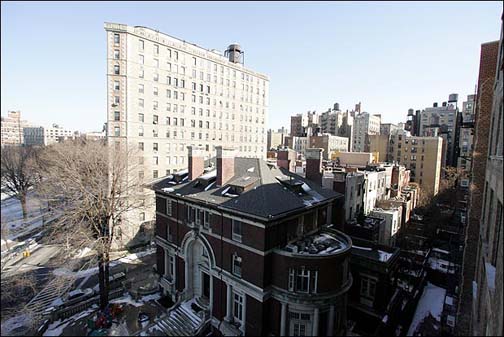 |
New York
Architecture Images-Upper West Side Yeshiva Ketana |
|||||||||
|
architect |
Herts & Tallant | |||||||||
|
location |
346 West 89th St. at Riverside Drive. | |||||||||
|
date |
1903 | |||||||||
|
style |
Beaux-Arts | |||||||||
|
construction |
brick | |||||||||
|
type |
House | |||||||||
|
|
||||||||||
|
images |
 |
|||||||||
|
|
||||||||||
|
||||||||||
|
A Landmarked Mansion, Past Its Prime, Casts
a Shadow on the Neighbors By SETH KUGEL Published: February 13, 2005 The Isaac L. Rice Mansion, a turn-of-the-century, four-story red brick dwelling at West 89th Street across from the Soldiers' and Sailors' Memorial, is one of only two free-standing houses of about 30 that used to dot Riverside Drive. But although the mansion is a designated landmark, its glory years are long gone. Most of the decorative copper has fallen off; the steps and the wall around the property are badly cracked; and residents of the co-op next door say the front yard has become such a dustbowl that on windy days, dirt filters into their apartments through screens and coats their furniture. Built for the early-20th-century businessman whose name it bears, the mansion is currently home to Yeshiva Ketana of Manhattan. And neighbors say the school fails to maintain the building properly. The yeshiva denies that there are problems, and Robert Tierney, chairman of the city's Landmarks Preservation Commission, described the school as a good steward of the building. The yeshiva has followed procedure in making exterior changes at least five times. The schoolyard is a key issue. Scott Miller, executive director of the 145-student yeshiva, said that it made no sense to aim for a grass yard of the sort Isaac Rice might have had, and that the lawn's condition was not part of the landmark decree. But a lawyer for the neighbors, Antonia Bryson, has argued that lawn maintenance is so required. In 1999, the yeshiva drew up plans to transform the yard into a play area with a safety surface that would cover the dust and be surrounded by greenery. But the neighbors rejected the idea, said Joan Rome, their leader. Over the last year, residents increased the pressure, first unsuccessfully asking the landmarks commission to pursue the yeshiva for failing to maintain the building, and then complaining to the Buildings Department. Last June the school was fined nearly $7,000 for violations, mostly for lacking a current certificate of occupancy. The school is seeking such a certificate, Mr. Miller said. In October, the department fined the yeshiva $2,000 for hazardous conditions on the steps and the concrete around the yard on Riverside Drive. The yeshiva is proceeding with a new plan to redesign the yard. "At some point," Mr. Miller said, "you have to say, this is something that's not getting anywhere." But any such change will have to go to the landmarks commission, so neighbors will still have their say. Ms. Rome said she hates not just the noise but the dust that drifts into her apartment when the windows are open, and the dirt runoff that can clog drains in her building's courtyard and cause flooding. "We know it's a school, and children have to play," Ms. Rome said. "But we think there needs to be some recognition on their part that people live and work all around." Copyright New York Times. |
||||||||||
|
links |
||||||||||